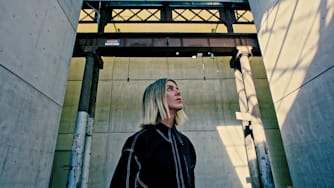Design Fest Ghent: caramel, corn, and circular creations
When visiting Ghent this spring, one may have caught the smell of caramel, sugar cane, and corn. Especially around Brabantdam 31. Not because the circus was in town, but because of another event. Design Fest Ghent, a new biennial design festival, showcases ground-breaking designs and sustainable innovations. Like the sweet-smelling, circular creation BreaZea.

BreaZea (Breathe In/Breathe Out) is a modular room divider made from bioplastics with a scent of caramel, sugar cane, and corn, meant to highlight the distinction between bioplastics and traditional plastics.To the naked eye, traditional plastics and bioplastics look the same, though they have very different properties. Conventional plastics are derived from petroleum or natural gas. Bioplastics, on the other hand, are derived from sugar derivatives produced from renewable biomass sources such as vegetable oils, corn starch, straw, food waste, and so on.Wanting to make this distinction clear, Moritz Maria Karl, architect, urban designer and founder of OFFICE MMK, and Vlasta Kubušová, co-founder of the design studio crafting plastics!, set out to give bioplastics an identity through smell, emphasising its unique properties that make it a circular material solution worth exploring. During late April, their piece was displayed in the Polestar Space in Ghent as part of the first edition of Design Fest Gent, filling the space on Brabantdam 31 with design enthusiasts. And the subtle scent of sweets.
We sat down to talk with Moritz and Vlasta about what inspired their creation.

Could you please introduce yourselves? Moritz: I’m Moritz. Architect, urban designer, and founder of Office MMK in Berlin. Together with Vlasta, I’ve created BreaZea. It was about three years ago that we first talked about how to give bioplastics an identity together.
Vlasta: I am the co-founder of the design studio crafting plastics. As a product designer, I look for sustainable ways to develop products. We want to understand the full life cycle of materials and products: from the origin, through the production phase, the degradation, the recycling, and the return to the cycle. We always strive for full control over a product.
What was your inspiration for BreaZea (Breathe In/ Breathe Out)?
Vlasta: We started with an obstacle: today, you cannot see the difference between bioplastics and traditional plastics with the naked eye. They look exactly the same. This makes it seem as if bioplastics make no difference to our society, but they do! We want to give bioplastics a new, recognisable identity. With BreaZea, we are trying to achieve this through smell.
Moritz: We very deliberately chose to use these bioplastics for a modular room divider. This allows us to introduce bioplastics into people's daily lives in a beautiful, useful, and visible way. We have also made sure that the installation is easy to assemble. Even the smallest child can do it.What materials did you use for BreaZea (Breathe In/Breathe Out)?
Vlasta: It took us two years to develop the material we worked with. We wanted to make a bioplastic that was strong, but also flexible. It had to be suitable for 3D-printing, be child-friendly, and of premium quality. The basis of the bioplastic we use for BreaZea are biopolymers made from sugar cane and corn starch.
Moritz: We were inspired by these two components to develop the scent for BreaZea. Over time the scent, which is subtle, also fades, so you know that your bioplastic is evolving, like all natural products.
Where does the title come from?
Moritz: BreaZea is actually not an existing word. It refers to breathing and making something visible. Because breathing is also something very subtle and normal. So normal that we hardly notice it. Just like we don't see if something is made of bioplastics. But the value of breathing is enormous, and it deserves to be seen. The same goes for sustainable materials.What message do you want to convey with the installation?
Vlasta: We want to make people aware of the origin of materials and the composition of products we use every day. The smell of the work should trigger people. Thanks to the smell, you are suddenly very aware of the presence of the work, which makes you think about it more quickly. That initial awareness is essential. We have to change the way we produce today; it has to become more sustainable.
Can BreaZea (Breathe In/ Breathe Out) be a solution to move towards a more sustainable society?
Moritz: We are a drop in the ocean. Our work will not make the difference on its own, but many initiatives together can. We show that materials, production, and design can be sustainable. Vlasta: We are proving that bioplastics can effectively leave the lab and be used in materials we use every day. Now we have to find a way to make it scalable. For this you need the big players, and we hope to inspire them.
The smells of caramel, corn, and sugar cane have a number of associations. The circus. The movies. And now, thanks to BreaZea, a more circular, sustainable world.


